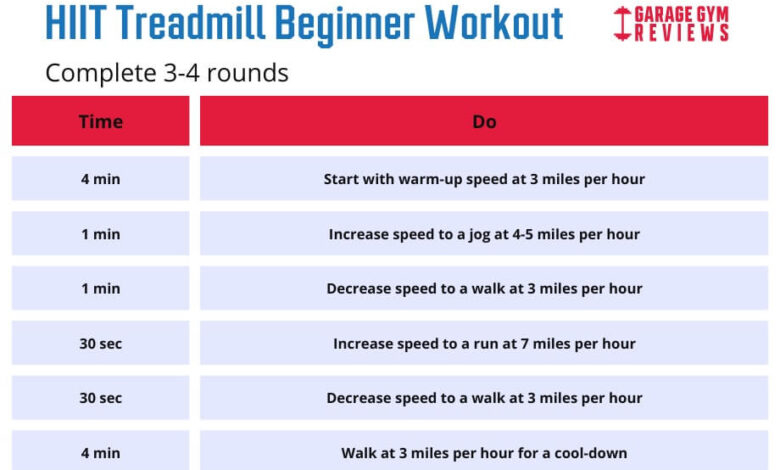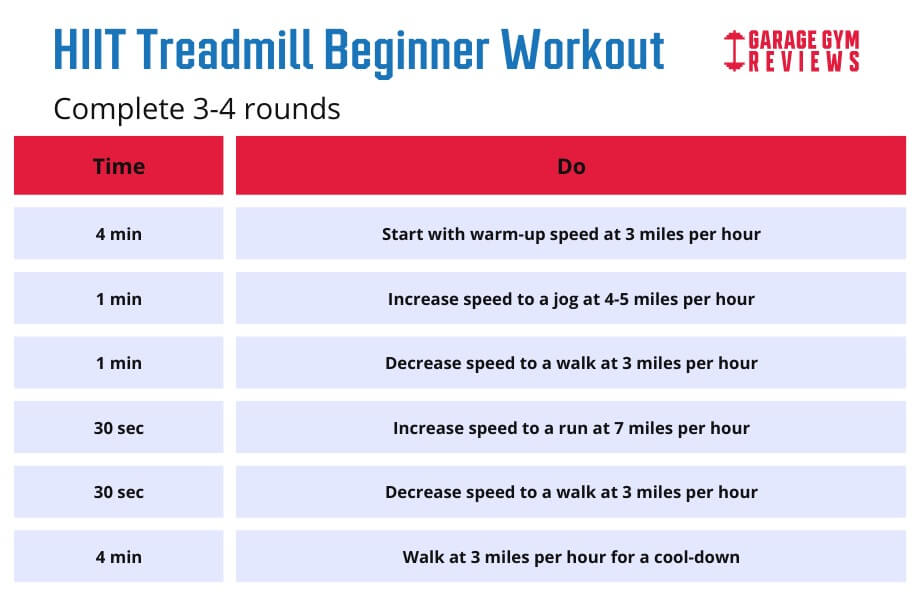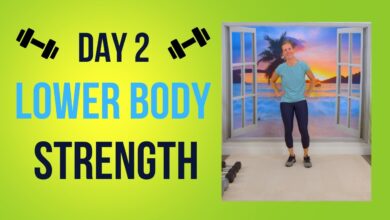
4 Week Treadmill Training Plan: Your Guide to Results
4 week treadmill training plan – Ready to take your fitness to the next level? A 4-week treadmill training plan can be your roadmap to achieving incredible results, whether you’re a seasoned runner or just starting out. This plan provides a structured approach to building endurance, strength, and speed, all while ensuring you stay motivated and injury-free.
Over the next four weeks, you’ll embark on a journey of progressive training, starting with building a solid foundation and gradually increasing intensity and duration. We’ll guide you through each stage, providing detailed workout schedules, warm-up and cool-down routines, and tips for proper form and technique.
You’ll also learn about the importance of nutrition, hydration, rest, and recovery, all crucial elements for maximizing your progress.
Warm-up and Cool-down
A proper warm-up and cool-down are essential components of any treadmill training program. They help prepare your body for the workout and prevent injuries. A warm-up gradually increases your heart rate and blood flow, while a cool-down helps your body recover and prevents muscle soreness.
Warm-up Routine
A warm-up should consist of dynamic stretches and light cardio. Dynamic stretches involve moving your body through a range of motion, while light cardio helps to elevate your heart rate and blood flow.Here is a sample warm-up routine:
- Light Cardio: Begin with 5 minutes of light cardio, such as walking at a moderate pace on the treadmill. This will help to increase your heart rate and blood flow.
- Dynamic Stretching: Perform the following dynamic stretches for 5-10 minutes, focusing on major muscle groups:
- Arm Circles: Stand with your feet shoulder-width apart and swing your arms in a circular motion, forward and backward.
- Leg Swings: Stand with your feet shoulder-width apart and swing one leg forward and backward, then repeat with the other leg.
- Torso Twists: Stand with your feet shoulder-width apart and twist your torso from side to side.
- High Knees: Jog in place, bringing your knees up to your chest.
- Butt Kicks: Jog in place, bringing your heels up to your buttocks.
Cool-down Routine
A cool-down should consist of static stretches and a gradual decrease in intensity. Static stretches involve holding a stretch for a period of time, while a gradual decrease in intensity allows your heart rate and blood flow to return to normal.Here is a sample cool-down routine:
- Gradual Decrease in Intensity: After your workout, gradually decrease your treadmill speed and incline for 5 minutes until you reach a walking pace. This will help your body recover and prevent muscle soreness.
- Static Stretching: Perform the following static stretches for 5-10 minutes, holding each stretch for 30 seconds:
- Calf Stretch: Stand facing a wall with your feet shoulder-width apart. Lean forward and place your hands on the wall, keeping your back straight. You should feel a stretch in your calf muscles.
- Hamstring Stretch: Sit on the floor with your legs extended in front of you. Reach down towards your toes, keeping your back straight. You should feel a stretch in your hamstring muscles.
- Quadriceps Stretch: Stand with your feet shoulder-width apart. Bend one leg and grab your foot with your hand, pulling your heel towards your buttock. You should feel a stretch in your quadriceps muscle.
- Chest Stretch: Stand with your feet shoulder-width apart. Interlace your fingers behind your back and lift your arms as high as you can. You should feel a stretch in your chest muscles.
- Shoulder Stretch: Stand with your feet shoulder-width apart. Reach one arm across your body and hold it with your other hand. Gently pull your arm across your body until you feel a stretch in your shoulder muscle.
Week 1
Welcome to week one of your treadmill training plan! This week is all about establishing a solid foundation and getting comfortable with the treadmill. We’ll be focusing on moderate intensity workouts with short bursts of high intensity to build your endurance and cardiovascular fitness.
Treadmill Workout Schedule
This week, you’ll be aiming for 3-4 sessions on the treadmill, each lasting around 30-40 minutes. The goal is to gradually increase your time and intensity as you progress. Here is a sample workout schedule for week 1:
Monday: Moderate Cardio
- Warm-up: 5 minutes at a light pace (walking or jogging)
- Moderate intensity: 20 minutes at a pace where you can comfortably hold a conversation
- Cool-down: 5 minutes at a light pace
Wednesday: Interval Training
- Warm-up: 5 minutes at a light pace
- Interval training: 20 minutes with 1-minute bursts of high intensity followed by 2 minutes of moderate intensity. (Repeat this cycle 10 times)
- Cool-down: 5 minutes at a light pace
Friday: Moderate Cardio
- Warm-up: 5 minutes at a light pace
- Moderate intensity: 25 minutes at a pace where you can comfortably hold a conversation
- Cool-down: 5 minutes at a light pace
Maintaining Proper Form and Posture
Maintaining proper form and posture on the treadmill is crucial for preventing injuries and maximizing your workout. Here are some key tips:
- Engage your core: This helps to stabilize your body and prevent strain on your back.
- Keep your shoulders relaxed and back straight: Avoid hunching over or slouching.
- Maintain a slight forward lean: This helps to engage your glutes and hamstrings.
- Land softly on your midfoot: This helps to absorb shock and reduce stress on your joints.
- Swing your arms naturally: This helps to maintain balance and improve your stride.
Remember to listen to your body and take breaks when needed. It’s important to gradually increase your intensity and duration as you get stronger.
Week 3
This week, we’ll focus on building endurance. We’ll be increasing the duration of our workouts and incorporating longer intervals of high intensity. This will help you improve your cardiovascular fitness and prepare you for the more challenging workouts to come.
A 4-week treadmill training plan can help you reach your fitness goals, but remember, consistency is key! Don’t forget to fuel your workouts with healthy meals – check out these diets and recipes for 35 minute dinners for some quick and nutritious inspiration.
A balanced diet combined with your treadmill training will help you feel your best and see real results.
Treadmill Workout Schedule for Week 3
This week, we’ll be working out three times a week, with one day of rest in between each workout. The workouts will consist of a warm-up, a treadmill session, and a cool-down. Here’s a sample workout schedule:
- Day 1:Warm-up, 30 minutes on the treadmill at a moderate intensity (60-70% of your maximum heart rate), Cool-down
- Day 2:Rest
- Day 3:Warm-up, 20 minutes on the treadmill at a moderate intensity (60-70% of your maximum heart rate), followed by 10 minutes of high intensity intervals (80-90% of your maximum heart rate), Cool-down
- Day 4:Rest
- Day 5:Warm-up, 30 minutes on the treadmill at a moderate intensity (60-70% of your maximum heart rate), Cool-down
- Day 6:Rest
- Day 7:Rest
Monitoring Heart Rate and Adjusting Intensity
Monitoring your heart rate is crucial for ensuring you’re working out at the right intensity. To calculate your maximum heart rate, subtract your age from 220. For example, if you are 30 years old, your maximum heart rate is 190 beats per minute.
A 4-week treadmill training plan can be a great way to boost your fitness and shed some pounds, but it’s important to remember that technology can be a double-edged sword when it comes to weight loss. It’s crucial to understand the technology dos and don’ts for weight loss to avoid falling into the trap of relying too heavily on gadgets and apps.
After all, a good training plan involves more than just the treadmill – it’s about consistency, dedication, and finding what works best for your body and lifestyle.
To find your target heart rate for moderate intensity, multiply your maximum heart rate by 60% and 70%.
To find your target heart rate for high intensity, multiply your maximum heart rate by 80% and 90%.
During your workout, you can use a heart rate monitor to track your heart rate. If your heart rate is too high, you need to slow down. If your heart rate is too low, you need to speed up. If you are new to exercise or have any health concerns, it’s always a good idea to consult with a doctor before starting any new exercise program.
Nutrition and Hydration: 4 Week Treadmill Training Plan
Fueling your body with the right nutrients is crucial for optimal performance and recovery during your treadmill training. Proper nutrition provides the energy you need for workouts and supports muscle repair and growth. Hydration is equally important, ensuring your body functions properly and prevents dehydration.
Nutrition for Treadmill Training
A balanced diet that includes carbohydrates, protein, and healthy fats is essential for athletes. Carbohydrates provide the primary energy source for your workouts, while protein supports muscle building and repair. Healthy fats provide essential nutrients and help regulate hormone production.
Here is a sample meal plan for athletes following a 4-week treadmill plan:
Sample Meal Plan
- Breakfast: Oatmeal with berries and nuts, or a whole-wheat toast with peanut butter and banana.
- Mid-morning snack: Greek yogurt with fruit or a handful of trail mix.
- Lunch: Grilled chicken salad with quinoa or a whole-wheat wrap with hummus and vegetables.
- Afternoon snack: A protein shake or a fruit smoothie.
- Dinner: Salmon with roasted vegetables or a lentil soup with whole-wheat bread.
This sample meal plan is a guideline and can be adjusted based on individual needs and preferences. It’s essential to consult with a registered dietitian or sports nutritionist for personalized guidance.
Hydration for Treadmill Training, 4 week treadmill training plan
Water is crucial for maintaining proper hydration during treadmill training. It helps regulate body temperature, transports nutrients, and removes waste products. Dehydration can lead to fatigue, muscle cramps, and decreased performance.
A 4-week treadmill training plan can be a great way to boost your cardiovascular fitness, but it’s important to approach it with a balanced mindset. Just like Kelsey learned when she ditched a crash diet and embraced a healthier lifestyle through MyFitnessPal, how a crash diet led kelsey to myfitnesspal and much healthier habits , sustainable fitness is all about gradual progress and long-term commitment.
With a 4-week treadmill plan, you’ll be able to track your improvements and gradually increase your endurance, making it a more enjoyable and rewarding experience.
Water Intake Guidelines
- Before training: Drink 16-20 ounces of water 2-3 hours before your workout.
- During training: Drink 4-8 ounces of water every 15-20 minutes during your workout, depending on the intensity and duration.
- After training: Replenish fluids by drinking 16-20 ounces of water for every pound of weight lost during your workout.
It’s important to note that individual hydration needs can vary based on factors like body weight, climate, and intensity of exercise.
Safety Considerations
Treadmill training can be an effective way to improve your fitness, but it’s important to prioritize safety to prevent injuries. By understanding and adhering to proper safety measures, you can maximize the benefits of your workouts while minimizing risks.
Using the Treadmill Safely
Before you begin, it’s crucial to familiarize yourself with the treadmill’s features and controls. This includes understanding how to adjust the speed, incline, and emergency stop button. Always start slowly and gradually increase the intensity as you become more comfortable.
- Start with a slow speed and incline.Gradually increase the speed and incline as you become more comfortable.
- Hold onto the handrails for balance.Especially when starting and stopping the treadmill.
- Wear appropriate footwear.Choose running shoes with good support and cushioning.
- Keep your surroundings clear.Ensure that there are no obstacles or loose objects around the treadmill.
- Use the safety key.The safety key is a small key that attaches to your clothing and disconnects the treadmill if you fall or trip.
- Avoid distractions.Don’t use your phone or watch TV while on the treadmill.
- Listen to your body.Stop if you experience any pain or discomfort.
Potential Risks and Mitigation
While treadmill training offers numerous benefits, there are potential risks associated with it. Being aware of these risks and implementing appropriate measures can significantly minimize their occurrence.
- Falls:Falls are the most common treadmill injury. To prevent falls, hold onto the handrails for balance, especially when starting and stopping the treadmill. Wear comfortable shoes with good support and cushioning.
- Overuse injuries:These injuries can occur if you train too hard or too frequently. To prevent overuse injuries, gradually increase your training intensity and duration. Incorporate rest days into your training schedule.
- Cardiovascular events:These are rare but can occur during intense exercise. If you have any underlying health conditions, consult your doctor before starting a new exercise program.
Emergency Procedures
It’s essential to know what to do in case of an emergency.
- If you fall, immediately press the emergency stop button.
- If someone else falls, immediately assist them and press the emergency stop button.
- Call for help if necessary.
Concluding Remarks

By the end of this 4-week treadmill training plan, you’ll have gained a deeper understanding of your body’s capabilities, experienced significant improvements in your fitness levels, and developed a love for the treadmill. Remember, consistency is key, and with each workout, you’ll be one step closer to achieving your fitness goals.
So lace up your shoes, step onto the treadmill, and get ready for an incredible transformation!




